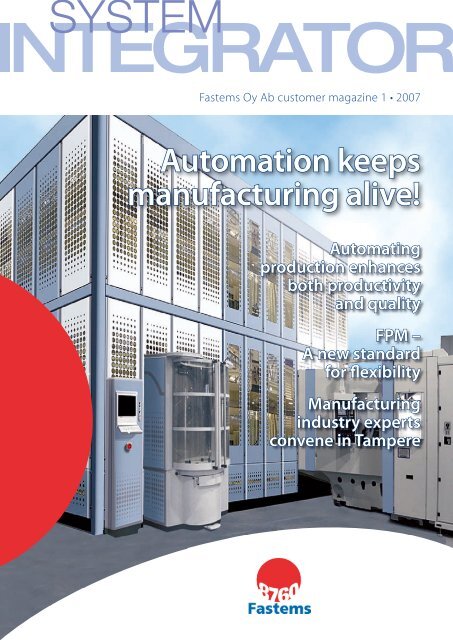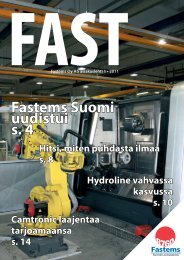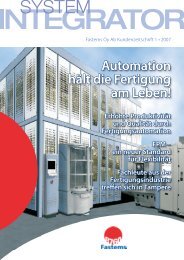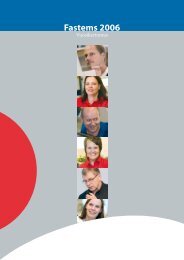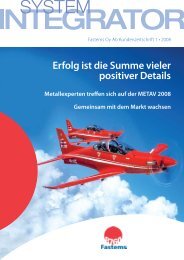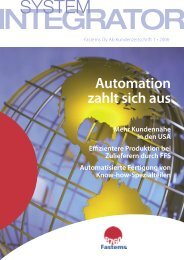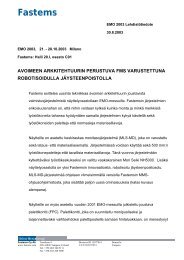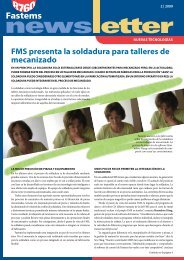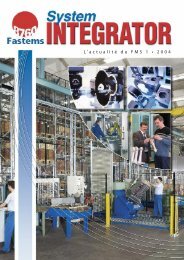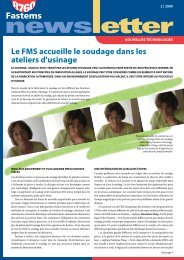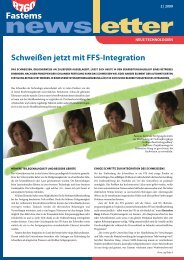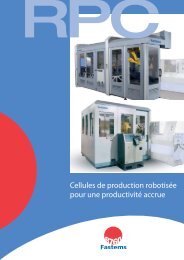Automation keeps manufacturing alive! - Fastems
Automation keeps manufacturing alive! - Fastems
Automation keeps manufacturing alive! - Fastems
You also want an ePaper? Increase the reach of your titles
YUMPU automatically turns print PDFs into web optimized ePapers that Google loves.
<strong>Fastems</strong> oy Ab customer magazine 1 • 2007<br />
<strong>Automation</strong> <strong>keeps</strong><br />
<strong>manufacturing</strong> <strong>alive</strong>!<br />
Automating<br />
production enhances<br />
both productivity<br />
and quality<br />
FPM –<br />
A new standard<br />
for fl exibility<br />
Manufacturing<br />
industry experts<br />
convene in Tampere<br />
1 • 2007 | 1
SYSTEM<br />
INTEGRATOR<br />
Editorial ..................................................................2<br />
<strong>Fastems</strong> at EMo 2007: <strong>Automation</strong><br />
<strong>keeps</strong> <strong>manufacturing</strong> <strong>alive</strong>! .......................3<br />
<strong>Fastems</strong> strengths its support<br />
in North America .............................................4<br />
Masco and <strong>Fastems</strong> team up<br />
to drive down cost .........................................6<br />
“The only limit for robot cells is<br />
our imagination” ...............................................8<br />
Automating production enhances<br />
both productivity and quality ..............10<br />
FPM – A new standard for flexibility ....12<br />
FPc raises efficiency in<br />
small machine shops .................................14<br />
RPc-20g increases productivity<br />
of production machines ..........................16<br />
<strong>Fastems</strong> and Finn-Power<br />
cooperation expands .................................17<br />
The multi-skilled Teleservice Team<br />
<strong>keeps</strong> customers’ systems running ....18<br />
Manufacturing industry experts<br />
convene in Tampere ....................................20<br />
Time-off ...............................................................22<br />
Tids and bits ......................................................23<br />
Published by FASTEMS Oy Ab<br />
No. 1/2007<br />
EDITOR-IN-CHIEF<br />
Helena Reilin, <strong>Fastems</strong> Oy Ab<br />
helena.reilin@fastems.com<br />
ENGLISH EDITION:<br />
Sari Lehtonen-Lammi, Imageneering Oy<br />
LAYOUT:<br />
Imageneering Oy<br />
EDITORIAL ADDRESS:<br />
System Integrator<br />
<strong>Fastems</strong> Oy Ab<br />
Tuotekatu 4, 33840 TAMPERE, FINLAND<br />
Tel. +358 (0)3 268 5111<br />
Fax. +358 (0)3 268 5000<br />
PRINTED BY:<br />
Kirjapaino Hermes Oy, Tampere,<br />
Finland 2007<br />
CONTRIBUTORS:<br />
Tomas Agdahl<br />
Tim Erman<br />
Robert Humphreys<br />
Jarmo Hyvönen<br />
Janne Konttila<br />
Klaus Maurmaier<br />
2 | 1 • 2007<br />
Matti Nurminen<br />
Janne Näsström<br />
Michael schott<br />
Peter springfeld<br />
Pekka Tuhkanen<br />
Jens von Weissenberg<br />
MANuFAcTuRINg<br />
TEchNoLogIEs –<br />
ENAbLINg<br />
TEchNoLogIEs<br />
E d i t o r i a l<br />
We are facing perhaps the biggest challenge of our times. Asian economies are rising and<br />
<strong>manufacturing</strong> focus is turning to the East. This change has begun and it will continue. In 2025,<br />
most of the working hands between 30-40 years of age will be found in Asia. so, who is going<br />
to do the <strong>manufacturing</strong> work in Europe and the usA? Is European <strong>manufacturing</strong> dying? No.<br />
success factors in Europe will depend on skilled people and their efficient tools.<br />
our strategic task is to develop these tools and see that the 8760 yearly production hours<br />
are efficiently used despite fewer hands to do the work. With this development we don’t just<br />
help our customers, but also the entire <strong>manufacturing</strong> industry. As <strong>manufacturing</strong> is increasingly<br />
carried out by sMEs, it is our task to offer solutions applicable both to larger and smaller<br />
companies. <strong>Fastems</strong> solutions will support the <strong>manufacturing</strong> strategies of both production<br />
types. The innovative FPM concept and our new and agile robot cells provide good examples<br />
of such products.<br />
New <strong>manufacturing</strong> technologies need to enable fast and cost effective material flow from<br />
bottom to top, from the first component to ready-to-use machinery. Therefore, we concentrate<br />
on solutions that connect machine tools and technologies together without any borders or<br />
closed standards. We offer solutions for companies who see that it is important to develop<br />
their <strong>manufacturing</strong> strategy according to best practices and according to the latest available<br />
technology. These companies are interested in creating effective and sustainable <strong>manufacturing</strong>.<br />
such <strong>manufacturing</strong> allow the flexibility for future challenges.<br />
Our goal is to ensure quality time for our customers. Time that means seeking new business<br />
opportunities, rather than guessing what went wrong with the production equipment, why the<br />
utilization rate of machine tools is so poor, why the throughput time too long, how staff can be<br />
kept motivated, or how the quality level can be raised as high as possible.<br />
At <strong>Fastems</strong>, we commit to solving those problems for you, and we want to be known for the<br />
success of our customers. our latest solutions will be showcased at EMo 2007, in hannover.<br />
I hope you visit us at EMo, and receive something precious to take back home. something that<br />
will help you in your daily work, ideas that will raise your competitiveness in this ever-tightening<br />
business, as well as tools that enable you to win the order.<br />
Jarmo Hyvönen,<br />
cEo<br />
<strong>Fastems</strong> group
<strong>Fastems</strong> at EMO 2007:<br />
<strong>Automation</strong> <strong>keeps</strong><br />
<strong>manufacturing</strong> <strong>alive</strong>!<br />
PREsERvINg ThE MANuFAcTuRINg INDusTRy Is A vALuAbLE goAL ThAT FAsTEMs<br />
shAREs WITh ITs cusToMERs.<br />
At EMO 2007, we will continue our role as<br />
an international pathfi nder in fl exible factory<br />
automation solutions for lean <strong>manufacturing</strong>.<br />
Th e latest technology highlights<br />
showcased at EMO will be introduced also<br />
in this magazine on pages 10‑14.<br />
automate for more<br />
production hours<br />
Th e goal for <strong>Fastems</strong> products, services and<br />
partnership is to ensure that the annually<br />
available 8760 production hours are utilised<br />
as effi ciently as possible. Th e over 600 FMS<br />
and nearly 100 FPC pallet containers in-<br />
stalled worldwide have already proven their<br />
ability to increase global competitiveness<br />
in the mechanical engineering, vehicle and<br />
aerospace industries.<br />
open doors into the<br />
metalworKing world<br />
Th e doors of the EMO exhibition in Hannover<br />
will be open from 17 to 22 September 2007.<br />
Th e absolute leading trade fair in the<br />
world of metalworking displays on the largest<br />
fairground premises of the world an unequalled<br />
width and depth of products and<br />
services throughout all production areas,<br />
READ MORE:<br />
pages 10-14!<br />
from machine tools to precision tools, auto- automation<br />
components to customised systems.<br />
Exhibitors from all over the world once<br />
again will put their effi ciency and innovative<br />
power to the test before the best qualifi ed<br />
international specialists.<br />
Th e visitors of EMO come from all levels<br />
of the trade, e.g. they are entrepreneurs,<br />
board members and managing directors,<br />
department heads as well as employees and<br />
skilled workers. Th ey work in the fi elds of<br />
production, operations scheduling, construction,<br />
R+D, as well as purchasing.<br />
1 • 2007 | 3
FASTEMS strengthen<br />
its support in NORTH<br />
expanded service support<br />
In January 2006 <strong>Fastems</strong> LLC was created to<br />
keep up with global demand for automation.<br />
Since then <strong>Fastems</strong> LLC based near Cincinnati<br />
has been building its support structure<br />
for the US market. Expansion has included<br />
service engineers based on the West Coast<br />
and in the Mid West USA. In the latter part<br />
of 2007 <strong>Fastems</strong> will add US based ‘teleservice’<br />
to their support portfolio. Teleservice<br />
enables <strong>Fastems</strong> to remotely access any<br />
system supplied giving customers a greater<br />
level of service support and helping to maximize<br />
the uptime of their <strong>Fastems</strong> system/s.<br />
deepening product support<br />
With over 120 years of production engineering<br />
experience, <strong>Fastems</strong> LLC product<br />
managers, led by Vice President Robert<br />
Humphreys, can off er our partners deep<br />
technical support.<br />
Pete Newbery, George Petruck and<br />
Don Gargiulo off er this technical support<br />
in the East, Mid West and West of the USA<br />
respectively. Th ese highly experienced engineers<br />
can provide automation solutions to<br />
our customers.<br />
4 | 1 • 2007<br />
Robert Humphreys, VP of <strong>Fastems</strong> LLC.<br />
it’s all aBout increased<br />
productivity<br />
We asked Robert Humphreys, VP of<br />
<strong>Fastems</strong> LLC, for his take on automation,<br />
the demands of <strong>manufacturing</strong> in North<br />
America today, and how <strong>Fastems</strong>’ product<br />
managers work with customers.<br />
Q. What does <strong>Fastems</strong> automation o� er the<br />
customer in today’s <strong>manufacturing</strong> world?<br />
A. “Th e key to meeting the requirements<br />
of the changing face of <strong>manufacturing</strong> is to<br />
off er automated systems with a competitive<br />
edge that increases productivity.”<br />
Q. You mention the changing face of <strong>manufacturing</strong>,<br />
what exactly do mean by this?<br />
A. “I recently attended a Manufacturing<br />
Summit where speakers from around the<br />
Product Manager George Petruck,<br />
Mid Western Area.<br />
world presented their views of <strong>manufacturing</strong><br />
today in the global economy, and none<br />
summed it better than John Byrd, the President<br />
of AMT (Th e Association for Manufacturing<br />
Technology). He said, ‘that although<br />
many say that <strong>manufacturing</strong> in North<br />
America is in decline and dying, contrary to<br />
this <strong>manufacturing</strong> (in North America) is<br />
in fact changing and evolving.’ Yes, there are<br />
less people employed in <strong>manufacturing</strong> but<br />
productivity is at its highest ever, this has<br />
been achieved through change and investment<br />
in technology. Th e only way to survive<br />
is to become more productive.”<br />
“So going back to my fi rst answer, I believe<br />
that the systems that <strong>Fastems</strong> off ers enable<br />
companies to change and invest in technology<br />
that increases productivity. Th e key<br />
words here are ‘increased productivity’.”<br />
Q. How does <strong>Fastems</strong> LLC help and enable<br />
customers in the US to change and evolve?<br />
A. “Each of our 3 product managers can of-
s AMERICA<br />
fer automation solutions that result in productivity<br />
increases. Typically we work with<br />
our machine tool partners and the end user<br />
and create a production solution, the aim is<br />
to increase productivity.”<br />
truly flexiBle <strong>manufacturing</strong><br />
Next, we asked about how diff erent customers<br />
use their <strong>Fastems</strong> systems, and what opportunities<br />
these bring.<br />
Q. What is a typical Flexible Manufacturing<br />
system and does it � t a certain pro� le or<br />
industry?<br />
A. “Interestingly, although we have over 60<br />
FM systems throughout North America and<br />
Western Area<br />
Don Gargiulo<br />
in many diff erent industries, none fi t a typical<br />
size or profi le. We have systems ranging<br />
from a single machine to multi-machine<br />
installations, some with high volume production<br />
with low variety and many with low<br />
volume batch production with high variety.<br />
We have systems <strong>manufacturing</strong> parts in<br />
aerospace through to automotive through to<br />
medical, OEM through to subcontractors.<br />
All systems aim to increase productivity, we<br />
can make a one off whilst maximizing spindle<br />
utilization, quite oft en over 90% whilst<br />
employing minimum labor.”<br />
Q. What would you say to customers interested<br />
in knowing more about <strong>Fastems</strong>?<br />
A. “I’d very much welcome any machine tool<br />
dealer or end customer to contact one of our<br />
product managers – aft er all, the best solutions<br />
come from open discussion.”<br />
System Integrator would like to thank Vice<br />
President Humphreys for taking the time to<br />
talk to us.<br />
Mid Western Area<br />
George Petruck<br />
Eastern Area<br />
Pete Newbery<br />
<strong>Fastems</strong> LLC<br />
1 • 2007 | 5
Masco <strong>Fastems</strong><br />
team up to drive down cost<br />
WhILE PRoDucTIvITy Is uP IN<br />
ToDAy’s bRAvE NEW WoRLD oF<br />
MANuFAcTuRINg, cosT Is ThE<br />
DRIvINg FoRcE. FLExIbILITy Is KEy<br />
IN TWo AREAs: ThE MAchININg<br />
cELL, AND ThosE PRovIDINg ThE<br />
EquIPMENT. A sToRy oF shARED<br />
vIsIoN ThAT bINDs TWo coMPANIEs<br />
IN A sPIRIT oF PARTNERshIP.<br />
6 | 1 • 2007<br />
Machinery Sales Company, also called<br />
Masco, knows that providing solutions is<br />
good for its business – and is even more critical<br />
to their customer’s prosperity (let alone<br />
survival) – than selling standalone machines.<br />
Such fl exible thinking has brought<br />
Masco and <strong>Fastems</strong> together, in a shared<br />
vision of “cost” and how it impacts manufacturers.<br />
“Price, quality, delivery: that is always<br />
the triangle,” states Garry Frost, Masco’s<br />
President of the City of Industry, California<br />
fi rm. “It’s very diffi cult to obtain all three.<br />
Parts produced with too high labor content<br />
will move to off shore production, you’ve got<br />
to reduce operator content,” says Frost.<br />
Four years ago Masco began to see the value<br />
in teaming up with <strong>Fastems</strong> USA., “We<br />
started to exploit the possibilities and realized<br />
that <strong>Fastems</strong> FMS was the right product<br />
for the market,” said Frost. And thus, the<br />
seeds of partnership took root.<br />
offer solutions, not Just<br />
machines<br />
Recognizing the possibility of providing<br />
cost-driven solutions, Masco introduced<br />
<strong>Fastems</strong> to Viking Products, Inc., where they<br />
sold two Kitamura HX400i units combined<br />
with a <strong>Fastems</strong> FMS. Another case is an installation<br />
at Aluminum Precision Products<br />
(APP), the system has helped to drive down
Bill Minna APP seen next to <strong>Fastems</strong><br />
system with Garry Frost of MASCO,<br />
discussion future expansion.<br />
costs whilst increasing productivity. Both<br />
cases show Masco as a “solution-driven”<br />
company.<br />
“<strong>Fastems</strong> is very flexible, they can integrate<br />
different machines into the same<br />
system. This flexibility helps to bring the<br />
solution to the cost, giving the end customer<br />
more options. It was just sort of possibility<br />
that APP’s Bill Minna liked.”<br />
automating at app<br />
“APP has a long history of cell <strong>manufacturing</strong>,”<br />
says Frost. “Bill Minna liked the<br />
possibility of using different machine sizes,<br />
or even different makes of machine in the<br />
same cell.” APP and Masco worked together<br />
to specify the Kitamura machines with the<br />
<strong>Fastems</strong>’ FMS and its advanced software<br />
system.<br />
“On an operator level, the man-cell<br />
controller interface is very well thought out,”<br />
continues Minna. “It allows a quick learning<br />
curve for existing shop floor personnel.”<br />
“APP has set its sight a high level of unattended<br />
operation, the <strong>Fastems</strong> system is enabling<br />
us to do just that,” adds Minna. APP<br />
compete in a Global market, with a shortage<br />
of workers and qualified operators they had<br />
no choice but to automate, streamline and<br />
go lean.<br />
“Beautiful friendship”<br />
People like APP’s Bill Minna have realized<br />
that in today’s <strong>manufacturing</strong> life: either the<br />
product is cost-competitive, or it goes offshore.<br />
When Masco and <strong>Fastems</strong> team up<br />
to make such good things happen, it brings<br />
to mind Humphrey Bogart’s memorable<br />
“Casablanca” exit line: “Louis, I think this<br />
is the beginning of a beautiful friendship,”<br />
concludes Frost.<br />
Increasing<br />
productivity<br />
at APP<br />
Aluminum Precision Products constantly<br />
looks at ways to improve efficiencies and<br />
reduce cost through lean <strong>manufacturing</strong>,<br />
total quality management and continuous<br />
process improvement. APP has invested in<br />
two Kitamura HX500s and one HX630 horizontal<br />
machining center integrated into a<br />
<strong>Fastems</strong> MLS_MD FM system (Multi-Level<br />
System) to achieve their goal.<br />
One of its products, a large landing gear, exemplifies<br />
APP’s goal of increasing productivity<br />
through flexibility.<br />
“With this machine tool investment we<br />
have cut machining time from 45 to about<br />
18 minutes,” notes APP’s machine engineering<br />
manager, Bill Minna. Another jet<br />
engine part was being produced at about six<br />
parts per hour, now that part is at a rate of<br />
8 to10 per hour, adding that “the <strong>Fastems</strong><br />
system enables quick reload of parts at the<br />
load stations, helping to maximizes spindle<br />
utilization’.<br />
“We do many different parts a month<br />
and run quite a bit through this cell,” adds<br />
Minna. The 27.2m (89.2feet) long cell has<br />
multi level storage for 42 pallets, most of<br />
which have aluminum tombstones that APP<br />
manufactures.<br />
Keeping customers happy<br />
Specializing in the forging of aluminum<br />
and titanium precision parts, APP had a<br />
demand to produce the aforementioned<br />
jet engine part. “The customer asked us<br />
to forge and machine double the previous<br />
quantity, we needed capacity immediately”.<br />
Masco was able to fill all our requirements<br />
with a Kitamura HMC, 12,000 RPM spindle,<br />
plus a number of other innovations<br />
“We had been looking at a <strong>Fastems</strong> system<br />
for some time, at this moment we have<br />
three Kitamuras integrated and are considering<br />
adding another. We won’t have to extend<br />
the <strong>Fastems</strong> system as there is enough<br />
space to integrate a fourth machine.”<br />
Minna says that his operators and maintenance<br />
personnel like the system “very<br />
much. “They were easily trained,” he notes.<br />
“We started installing the system about<br />
January 4, after we came back from Christmas<br />
shutdown, and it was up and running<br />
by February 1. It’s been running ever since.<br />
Reliability has been great. It has enabled us<br />
to get greater productivity and compete in<br />
an ever-changing market”.<br />
1 • 2007 | 7
“The only<br />
limit for robot<br />
cells is our<br />
imagination”<br />
8 | 1 • 2007<br />
TWo FAsTEMs RoboTIzED<br />
PRoDucTIoN cELLs ARE hELPINg oNE<br />
oF sWEDEN’s LARgEsT MEchANIcAL<br />
ENgINEERINg coMPANIEs To bEcoME<br />
EvEN MoRE coMPETITIvE.<br />
“ThE INsTALLATIoN hAs ExcEEDED<br />
ouR ExPEcTATIoNs,” sAys HARRY<br />
RAjALA, PRoDucTIoN MANAgER AT<br />
PARTNERTEch IN KARLsKogA, sWEDEN.<br />
PartnerTech is a group of companies that<br />
develops and manufactures products for<br />
several of the industry’s leading brands.<br />
They manufacture everything from telecommunications<br />
equipment to defense<br />
materials. The factory in Karlskoga is one<br />
of the largest cutting machining factories<br />
in the world, with approximately 100 CNC<br />
machines.<br />
Competition in the field is fierce and<br />
PartnerTech has an ambitious investment<br />
program. One priority is the automated<br />
material handling. The company invests in<br />
new machines with the required technology<br />
and also in material handling equipment<br />
that complements existing machines.<br />
“<strong>Fastems</strong> presented a turn-key solution<br />
with a portal robot that docks with the
machine,” says Kent Sandberg, who is in<br />
charge of the investment program.<br />
more advanced tasKs<br />
The first robotized production cell was installed<br />
at the beginning of 2006. It was a<br />
<strong>Fastems</strong> RPC-20G modular portal robot that<br />
was mounted on a 15-year-old Okuma CNC<br />
lathe. <strong>Fastems</strong> delivered the complete system<br />
pre-programmed and installation was over<br />
in less than a week. After a couple of days of<br />
training and fine-tuning, the system went<br />
into production.<br />
“The robot cell has functioned almost<br />
perfectly from the very first moment,” comments<br />
operator Tomas Forsberg.<br />
The original idea was that the life of an obsolete<br />
machine could be extended with the<br />
help of a robot and the system could keep<br />
producing at least fairly simple components.<br />
However, the system worked so well that the<br />
robot cell was soon assigned to more advanced<br />
production tasks.<br />
time for inspections<br />
With the success of the first robot cell, the<br />
idea to robotize another machine followed<br />
quickly. The machine next door was an Index<br />
G300 lathe with nine spindles and was<br />
selected to be upgraded. The second <strong>Fastems</strong><br />
RPC-20G was installed at the end of 2006,<br />
this time with the aim of fine-tuning a machine<br />
that was used for machining advanced<br />
components with tight tolerances. The products<br />
in this case were defense materials that<br />
required inspection at an individual level.<br />
“I can now manage several machines<br />
and I have time to inspect the products<br />
while the robots are charging and emptying<br />
the lathes,” says Tomas Forsberg.<br />
“We have yet to exhaust the full potential of the robot cell. The limit is set by our imagination,”<br />
says Harry Rajala (left) to which Kent Sandberg agrees.<br />
The process starts by placing the blanks<br />
on pallet trolleys in the cell. The robot picks<br />
up one blank at a time. The control systems<br />
of the robot and the lathe communicate with<br />
each other and the robot loads the lathe with<br />
work pieces. Once machining is complete,<br />
the lathe is emptied and the robot switches<br />
to standby mode for a moment. If the operator<br />
presses a button, the finished work piece<br />
is delivered for inspection through a “letterbox”.<br />
Otherwise, the work piece is placed on<br />
the pallet and the next blank is picked up.<br />
“Production continues even if I do not<br />
have the time to receive the work piece,” says<br />
Tomas Forsberg.<br />
flexiBle productivity<br />
<strong>Fastems</strong> programs the robot cell on-site. The<br />
basic program is adapted to new products<br />
by operating the robot in manual mode and<br />
teaching it the new operations. The process<br />
is simple and PartnerTech was able to rapidly<br />
change production once the potential of<br />
the system was understood.<br />
Both machines are operated five days a<br />
week in a three-shift. When <strong>manufacturing</strong><br />
products that do not need individual inspection,<br />
the magazine is loaded by the last shift<br />
of the week and the machine then runs automatically<br />
until the pallets are empty.<br />
“We have yet to exhaust the full potential<br />
of the robot cell. There is more to be<br />
done. The only limit is our imagination,”<br />
says Harry Rajala.<br />
According to Mr. Rajala, evidence shows<br />
that the investment is producing a better return<br />
in terms of productivity, flexibility and<br />
availability than PartnerTech expected.<br />
The second robot cell was installed on one of<br />
PartnerTech’s more advanced machines, a<br />
nine-spindle lathe.<br />
1 • 2007 | 9
Automating production enhances<br />
both productivity and quality<br />
<strong>Fastems</strong> Flexible Manufacturing System increases machine utilization<br />
AuToMATINg MANuFAcTuRINg PRocEssEs Is oNE oF ThE MosT DEPENDAbLE<br />
METhoDs oF INcREAsINg ThE uTILIzATIoN oF MAchINEs AND EquIPMENT,<br />
AND ENsuRINg RELIAbLE PRoDucTIoN WITh coNsIsTENTLy hIgh quALITy. by<br />
succEssFuL AuToMATINg MANuFAcTuRE oF ThEIR RANgE oF sAFETy vALvE<br />
housINgs, ThE PRojEcT TEAM REsPoNsIbLE FoR vALvE boDy PRoDucTIoN AT ThE<br />
hohENWEsTEDT PLANT oF LEsER gMbh & co. Kg, IN gERMANy, ALso AcquIRED A<br />
sERIEs oF ExTRA RATIoNALIzATIoN soLuTIoNs IN ThE PRocEss. IN TWo hoRIzoNTAL<br />
MAchININg cENTREs, AuToMATED FEED-IN AND REMovAL oF WoRK PIEcEs Is<br />
PERFoRMED by A FLExIbLE MANuFAcTuRINg sysTEM FRoM ThE FINNIsh coMPANy<br />
FAsTEMs.<br />
Originally founded as a brassfoundry in<br />
Hamburg in 1818, the company known today<br />
as Leser GmbH & Co. KG has enjoyed<br />
a success story that has lasted almost two<br />
hundred years. Working from the outset as a<br />
supplier, it has always concerned itself with<br />
effective development, setting new trends<br />
and pointing the way forward wherever possible.<br />
The company developed its first safety<br />
valves for use in steam boilers in 1885 and,<br />
even back then, the safety of people and the<br />
10 | 1 • 2007<br />
environment was the goal of Leser products.<br />
It was in the 1970s that the company then<br />
switched its focus to safety valves.<br />
Safety valves secure equipment and<br />
pipeline systems against unwanted pressure<br />
surges in a wide range of industrial plants,<br />
subsequently preventing explosions and protecting<br />
people, the environment and equipment<br />
from injury or damage. Generally<br />
speaking, they form the last link in the safety<br />
chain. For this reason, it is essential that they<br />
The <strong>Fastems</strong> MLS-MD system connects two<br />
DBF 630 machining centres to a Flexible<br />
Manufacturing System.<br />
work flawlessly. This means demands with<br />
regards to development, design and <strong>manufacturing</strong><br />
quality are high.<br />
“The Leser Company is one of the world’s<br />
leading manufacturers of quality safety<br />
The automatic stacker crane operates shelves<br />
with a maximum height of 20 meters and up<br />
to 150 meters long.
valves,” says CEO Joachim Klaus with a<br />
smile. “Our product range comprises a total of<br />
seven product groups with 38 types of safety<br />
valves. With a wide variety of materials and<br />
valve sizes in nominal widths from DN 10 to<br />
DN 400, 1/2“ to 16“, the company provides<br />
safe solutions for all industrial applications.<br />
Annual production is currently around 75,000<br />
safety valves and is increasing constantly, and<br />
we expect considerable growth in demand<br />
for our larger safety valves in particular.” “In<br />
light of this forecast,” adds production planning<br />
manager Kai‑Uwe Weiss “it was decided<br />
two years ago that a replacement investment<br />
was necessary for two of our older machining<br />
centres. We solved the challenges facing us<br />
by means of an automation project, which we<br />
called ‘Innopac’.<br />
automation solution<br />
requirements<br />
“As with all automation projects”, admits<br />
Joachim Klaus, “we too wondered how we<br />
might solve one of the key problems, namely<br />
how to integrate, for our business, batch size<br />
one <strong>manufacturing</strong> orders into the automated<br />
<strong>manufacturing</strong> process.” “Based on our team’s<br />
experience” notes Kai-Uwe Weiss, “we added<br />
an additional requirement in our specifications<br />
in the call for tenders: the two machining<br />
centres had to be capable of machining<br />
the clamped pieces in one or at maximum<br />
two clampings with a horizontal spindle”<br />
“Today we know that it was precisely by<br />
meeting this requirement”, stresses Joachim<br />
Klaus, “that were able to achieve such good<br />
results for rationalization. Whereas before six<br />
or seven clampings on various machines were<br />
necessary, we now manufacture our safety<br />
valve housings using one or at the most two<br />
clampings.”<br />
rationalization solutions in<br />
<strong>manufacturing</strong><br />
Matthias Hoffmann learned the job of a<br />
machine setter in the company and became<br />
involved in the automation project right<br />
from the start. He says that, “all machine<br />
pallets in the Flexible Manufacturing System<br />
are loaded and unloaded in the two loading<br />
stations. These carry either clamping<br />
systems for small parts or hydraulic chain<br />
clamping systems for machining valve housings.<br />
This type of clamping ensures the tension<br />
is distributed evenly across the entire<br />
workpiece and also enhances the quality of<br />
the processing. It’s also a lot faster, taking 30<br />
seconds at the most.”<br />
“The machining centres we chose”,<br />
explains Kai-Uwe Weiss, “are DBF 630s,<br />
which are made by Doerries Scharmann<br />
Technologie GmbH. With these, the clampings<br />
previously required for machining on<br />
the lathe are no longer necessary. This was<br />
A compact MLS-MD system (Multi-Level-System) and, from left: Machine operators Heiko<br />
Rathjen, Matthias Hoffmann with Klaus Maurmaier, <strong>Fastems</strong> Sales Manager for Germany,<br />
Production Planning Manager Kai-Uwe Weiss and Frank Turm, CNC Programmer.<br />
one of the key reasons it was worth using a<br />
<strong>Fastems</strong> Flexible Manufacturing System for<br />
automation. Additionally though, automated<br />
production processes ensure a high processing<br />
quality – the machining quality of the<br />
valve seat sealing surfaces is one of the defining<br />
criteria for the quality of a safety valve.<br />
Secondly, we needed to integrate an automatic<br />
joining operation in the machining process.<br />
This involves automatic assembly and subsequent<br />
machining of the valve seat socket in<br />
the safety valve housing, which is monitored<br />
by the control system. The standard versions<br />
of the DBF 630 machining centres also contribute<br />
greatly to reducing the clamping work.<br />
Bearing all these things in mind, we made<br />
Doerries Scharmann Technologie GmbH the<br />
general contractor for implementing our automation<br />
plan. Doerries Scharmann then got<br />
the Finnish company <strong>Fastems</strong> involved in the<br />
project, whose Flexible Manufacturing System<br />
provided the basis for fully automated operation<br />
of the two DBF 630 machining centres.”<br />
automated worKpiece handling<br />
“Our goal,” says Kai-Uwe Weiss, “of having<br />
at least every third shift unmanned could<br />
only be achieved by automating in-feed and<br />
removal of workpieces. The <strong>Fastems</strong> Flexible<br />
Manufacturing System offers, as other companies<br />
have told us, the best options for automatic<br />
operation of machining centres. Users<br />
of <strong>Fastems</strong> Flexible Manufacturing Systems<br />
really do get closer to the aim of using the<br />
8760 hours theoretically available each year<br />
more productively. Besides the recommendation<br />
by Doerries Scharmann, we were also<br />
convinced of the value of the <strong>Fastems</strong> Flexible<br />
Manufacturing System by the fact that<br />
nearly all the best known tool machine manufacturers<br />
have installed <strong>Fastems</strong> systems<br />
and all speak highly of them.<br />
“We work with cast parts,” Kai-Uwe<br />
Weiss reminds us. “Cast parts are not always<br />
homogenous. This means you have to reckon<br />
on a tool break even during unmanned<br />
night shifts.” “When this happens,” adds<br />
Klaus Maurmaier “the machine detects the<br />
tool break and reports this to <strong>Fastems</strong> system<br />
control and the pallet is removed and<br />
marked. Before continuing with a new pallet,<br />
the FMS control system checks whether all<br />
tools are still available, replacing broken tools<br />
if necessary.”<br />
fast implementation<br />
“Even looking back today,” says managing director<br />
Joachim Klaus, “the decision we made<br />
shortly before Christmas 2005 with regards<br />
to the complex rationalization project was the<br />
correct one. The <strong>Fastems</strong> system was installed<br />
back in September 2006 and the team that<br />
did it was great – they assembled it within ten<br />
days. By November the machining centres<br />
were connected up to the <strong>Fastems</strong> Flexible<br />
Manufacturing System. And they were wired<br />
up to the <strong>Fastems</strong> Control System in no time<br />
at all too – less than three days. It was at this<br />
point we realized we were dealing with professionals.<br />
And we were able to witness how<br />
well it performed straight away. Even while<br />
the automatic <strong>manufacturing</strong> system was being<br />
commissioned, we received a large order,<br />
which we were able to turn out rapidly.”<br />
1 • 2007 | 11
12 | 1 • 2007<br />
FPM<br />
– A new standard for fl exibility<br />
ThE FAsTEMs FLExIbLE PALLET MAgAzINE, FPM, Is A coNFIguRAbLE, FLExIbLE<br />
MANuFAcTuRINg sysTEM ThAT oFFERs you vERsATILITy IN sIzE, MAchINE NuMbER<br />
AND coNTRoL FEATuREs. INTRoDucED AT EMo 2007, ThE NEW gENERATIoN FPM Is<br />
READy To ENhANcE youR PRoDucTIvITy WITh sEvERAL NEW FEATuREs.<br />
EMO<br />
highlights<br />
highlights<br />
2007
Th e Flexible Pallet magazine provides a cost eff ective alternative<br />
for more fl exibility, when the tailored MLS system seems too big<br />
an investment and the FPC container is not quite enough anymore.<br />
Based on standard modules with confi gurable options, FPM creates<br />
an ideal and easily aff ordable solution for machining workshops to<br />
increase their automation level and unmanned production.<br />
“FPM is a standard product that ensures fl exibility and expandability,”<br />
says Matti Nurminen, R&D Manager of <strong>Fastems</strong>. “Th is<br />
product has been developed to improve the effi ciency of your entire<br />
workshop, as it can grow along with your goals from a one to ten<br />
machine system, if needed.”<br />
made for users<br />
A new control system provides FPM users with an easy-to-learn<br />
and easy-to-use graphical interface that guides and supports users<br />
in their diff erent tasks and <strong>manufacturing</strong> operations. “Th ese control<br />
functions are not only simple to use but also extremely fl exible,”<br />
Nurminen emphasises. “Th e control system extends in response to<br />
your needs and the same system supports <strong>manufacturing</strong> of both<br />
large batches and single parts.”<br />
“A further advantage is the working ergonomics. Th e loading<br />
station has been designed to allow users to work in more comfortable<br />
and ergonomic positions,” Nurminen continues.<br />
matched with production<br />
Th e modular system grows together with your production goals – as<br />
far as your vision can take you. “At its smallest, the system consists<br />
of a machine tool, loading station and storage rack for 12 machine<br />
pallets,” Janne Konttila, Product Manager of <strong>Fastems</strong> points out.<br />
“With extension modules you can increase the storage capacity to<br />
more than 100 machine pallets and ten machine tools”<br />
“Another interesting option is the multi-face machining functionality<br />
of the control system, which enables automatic scheduling<br />
of parts without the operator’s involvement. Th is allows making the<br />
most urgent pieces fi rst and helps minimise the number of required<br />
pallets and tools,” Konttila continues.<br />
plug and produce<br />
“Th e new generation FPM has also been designed with special focus<br />
on quick installation and easy maintenance”, Konttila states. “Confi<br />
gurable standard modules ensure quick installation and start-up,<br />
which means that the investment pay-back starts rapidly,” he states.<br />
“As a reliable system, FPM supports preventive maintenance. For in-<br />
Matti Nurminen (left ) and Janne Konttila.<br />
High usability with<br />
a new generation<br />
graphical user interface.<br />
Th e stacker crane is<br />
suitable for modern<br />
MCs.<br />
stance, easily accessible lubrication points permit servicing without<br />
extra disassembly.”<br />
“Of course, you can also request <strong>Fastems</strong> comprehensive service<br />
packages and make your easy maintenance no maintenance at all.<br />
Th is way you can concentrate solely on your core business,” Konttila<br />
concludes.<br />
ideal for machine manufacturers<br />
Th e FPM’s strengths are evident not only to parts manufacturers but<br />
also to machine suppliers who gain the opportunity to easily integrate<br />
state-of-the-art pallet automation into their machines.<br />
“Th e confi gurable, simple and user-friendly system is easy to<br />
supply with diff erent machines for various customers. Th e open<br />
control interfaces allow machine suppliers to customise their own<br />
functionalities, such as reporting. Also, the exterior appearance can<br />
be adapted to the machine supplier’s own colours. When needed we<br />
will give full support for integration and training,” Matti Nurminen<br />
says, listing benefi ts.<br />
FPM off ers an excellent example of <strong>Fastems</strong> off ering to machine<br />
manufacturers. “We want to serve machine suppliers with easy automation<br />
integration. In the future, we will put even more emphasis<br />
on the features that ensure easy supplier-specifi c customising.”<br />
1 • 2007 | 13
ThE FLExIbLE PALLET hANDLINg coNTAINER, FPc, PRovIDEs A cosT-EFFEcTIvE<br />
sTART ToWARDs FAcToRy AuToMATIoN AND AchIEvINg FuLL usE oF ALL 8760<br />
PRoDucTIoN houRs IN A yEAR. ThE sTANDARD PAcKAgE hAs bEEN uPDATED WITh<br />
NEW vALuE-ADDINg FEATuREs AND Is NoW RELEAsED As ThE FPc vERsIoN 4.0.<br />
14 | 1 • 2007<br />
The FPC is a standard solution for integrating<br />
up to two equal machines in a smart way.<br />
As such it offers new possibilities for small<br />
manufacturers and subcontractors that are<br />
striving for additional production output<br />
from one or two machining centres.<br />
FPC<br />
raises efficiency in small machine shops
EMO<br />
highlights<br />
highlights<br />
2007<br />
attractive in price<br />
Th e FPC provides a complete FM system in a<br />
container. Compared to a conventional pallet<br />
pool the FPC does not diff er much in price<br />
but it has a smaller footprint and is more effi -<br />
cient at delivering fi xtured components to the<br />
Th e <strong>Fastems</strong> Flexible Pallet Container (FPC) expands from a single container unit to a full-scale<br />
three-machine system, turning your machining centres into automated FM systems.<br />
machine spindles. Th e FPCs are as well suited<br />
to machining one-off s and small batches as<br />
they are to series production.<br />
more speed and efficiency<br />
Modern machining centres are good at<br />
maximising metal-cutting and minimising<br />
air-cutting by off ering high-speed and highpower<br />
spindles, fast axis movements and<br />
rapid tool changes. But a machine is only able<br />
to deliver its high production potential aft er<br />
the fi xtured workpiece has been presented to<br />
the spindle. Th is is where our FPC comes in,<br />
increasing pallet turnaround speed signifi -<br />
cantly compared with twin-APC or palletpool<br />
systems.<br />
start with one and expand to two<br />
Th e container range comprises four models<br />
covering pallet sizes from 400 mm x<br />
400 mm up to 1,000 mm x 1,000 mm and<br />
loads of up to 3.2 tonnes. Th e latter is the<br />
heaviest duty system and accommodates<br />
four pallets on one level, while the lightest<br />
system with a 750 kg load capacity stores 12<br />
pallets on two levels.<br />
Only one FPC may be needed at the<br />
outset, but a second can be retrofi tted at any<br />
time, increasing the pallet capacity of the<br />
lightest system to 24. At a maximum a twomachine-system<br />
is possible.<br />
up and running in a day<br />
Each FPC container is confi gured to suit the<br />
particular machining centre. Th e entire system<br />
can be unpacked, connected electrically<br />
and mechanically, and taken into operation<br />
the same day.<br />
in control<br />
Th e FPC’s control system is based on the<br />
Windows PC-based MMS, also used in other<br />
<strong>Fastems</strong> systems. Th is system is responsible<br />
for scheduling automatic pallet transfer on a<br />
fi rst-in, fi rst-out basis between load stations<br />
and machining centres – and via the store if<br />
the intended machine is occupied. Manual<br />
override is available for promoting a rush job<br />
to the head of the queue.<br />
every time and everywhere<br />
A further benefi t off ered by MMS controls,<br />
is the wealth of management data, including<br />
machine, load station and crane utilisation<br />
fi gures, reasons for spindle down-time, as<br />
well as daily, weekly or monthly production<br />
reporting.<br />
Th is information can be available on the<br />
factory fl oor, in the offi ce, or anywhere in<br />
the world via the web. Machine status monitoring<br />
and analysis provide interesting options,<br />
as does the sending of remote alarms<br />
via mobile phone text or e-mail messages.<br />
1 • 2007 | 15
RPC-20G<br />
increases productivity of production machines<br />
FAsTEMs’ MoDuLAR RoboT cELLs cREATE A NATuRAL FIRsT sTEP FoR youR<br />
FAcToRy AuToMATIoN. ThE RPc-20g oFFERs you A coMPLETE soLuTIoN FoR<br />
INcREAsINg ThE PRoDucTIvITy oF youR PRoDucTIoN MAchINERy. AT EMo, WE<br />
WILL shoWcAsE ThE LATEsT vERsIoN oF ThIs sTATE-oF-ThE-ART RoboT cELL.<br />
Th e RPC (Robotized Production Cell) series<br />
of robot cells enables companies to increase<br />
the utilization rate of existing machinery with<br />
a small investment.<br />
RPC-G is a modular robot cell designed<br />
for the loading and unloading of workpieces to<br />
various CNC machines and especially lathes.<br />
“With this cell you can easily cope with<br />
large variations in production volumes and<br />
with the readily available options you can<br />
adapt it to other applications, including workpiece<br />
fi nishing and gauging, says Ari Lylynoja,<br />
product manager for RPC-20G.<br />
“Th e product consists of a single transferable<br />
unit that enables fast installation and, if<br />
necessary, easy relocation of the system,” he<br />
continues.<br />
new construction for more<br />
possiBilities<br />
Th e updated RPC-20G has been designed<br />
with a new and narrower construction,<br />
16 | 1 • 2007<br />
which reduces the required fl oor space and<br />
minimizes the risk of transportation damage.<br />
With its new improved construction, RPC-<br />
20G allows for easy integration to large turning-milling<br />
centers.<br />
Th e new version also off ers a wider selection<br />
of options, including automatic tool<br />
change and a deburring brushing station, as<br />
well as a machine vision system.<br />
automate with minimum effort<br />
With this robot cell both new and existing<br />
machines can be automated with minimum<br />
eff ort. Th e gantry concept provides good<br />
accessibility to the machine tool in manual<br />
mode, as well as easy implementation of diverse<br />
material feed designs that can be geared<br />
EMO<br />
highlights<br />
highlights<br />
2007<br />
to the workpieces, quantities, and physical<br />
size.<br />
“Th e RPC further allows for quick and<br />
fl exible adaptation to today’s rapidly changing<br />
production requirements, as well as offering<br />
the operators more freedom for item<br />
handling.”
FAsTEMs AND FINN-PoWER AgREE To coNTINuE MANuFAcTuRINg AND<br />
DEvELoPINg MATERIAL AuToMATIoN coMPoNENTs FoR FINN-PoWER’s NIghT<br />
TRAIN FM sysTEMs.<br />
On May the 7th, 2007, <strong>Fastems</strong> and Finn-<br />
Power signed new cooperation agreement to<br />
manufacture and develop material automation<br />
components for Finn-Power’s Night<br />
Train FMS. The agreement is in force from<br />
1.9.2007 whereafter the full supply responsibility<br />
shifts to <strong>Fastems</strong> on 1.1.2008.<br />
This agreement continues cooperation<br />
between <strong>Fastems</strong> and Finn-Power, the Finnish<br />
sheet metal turret punch machine maker.<br />
For the last few years <strong>Fastems</strong> has already<br />
been <strong>manufacturing</strong> stacker cranes for Finn-<br />
Power.<br />
leading sheet metal technology<br />
Finn-Power is one of the world’s leading<br />
sheet metal working technology and<br />
machine suppliers. A significant portion<br />
of Finn-Power’s turnover is generated by<br />
automated cell and system products that<br />
are capable of unmanned production. The<br />
market demand, especially of high technology<br />
products, is increasing and the company<br />
supports its global development strategy<br />
through deep cooperation with selected<br />
partners. This cooperation aims to harness<br />
competitive advantages from both new construction<br />
solutions and more focused production<br />
capacity.<br />
growth and cooperation<br />
One element of <strong>Fastems</strong>’ growth strategy<br />
is to deliver proven system components to<br />
customers outside their own direct customer<br />
segments, and the new agreement is a good<br />
example of this. The close cooperation be-<br />
Tomas Hedenborg, CEO,<br />
Finn-Power (left) and Jarmo<br />
Hyvönen, CEO, <strong>Fastems</strong>.<br />
<strong>Fastems</strong> and Finn-Power<br />
cooperation expands<br />
tween <strong>Fastems</strong> and Finn-Power offers both<br />
parties a competitive advantage, with Finn-<br />
Power gaining added value from the expert<br />
partner in their own field. As such, the Finn-<br />
Power Night Train FMS® brand will continue<br />
to be combined with <strong>Fastems</strong>’ trade<br />
name addition. Machine interfaces, control<br />
systems, installation-service and spare part<br />
services will remain at Finn-Power.<br />
“Tight cooperation between <strong>Fastems</strong><br />
and Finn-Power, the leaders in their respective<br />
fields, benefits both companies and their<br />
customers. At <strong>Fastems</strong>, we are delighted<br />
to be serving customers in new markets<br />
with our technology and know-how. This is<br />
what mutual success is all about, ” says Juha<br />
Pihlajamaa, Product Manager, Finn-Power<br />
products.<br />
1 • 2007 | 17
WhEN A vIsIToR ENTERs FAsTEMs’ LoWER Lobby<br />
IN ThE LAhDEsjäRvI oFFIcE IN TAMPERE, FINLAND,<br />
ThE FIRsT ThINg ThEy sEE Is A gLAss WALL, bEhIND<br />
WhIch ThERE ARE sEvERAL MoNIToRs. NExT To<br />
ThEsE Is A gRouP oF PEoPLE FocusED oN ThEIR<br />
WoRK AND coNTINuousLy TALKINg oN ThEIR<br />
PhoNEs. ThIs Is A vIEW FRoM ThE hEART oF<br />
FAsTEMs’ REMoTE sERvIcE – FAsTEMs TELEsERvIcE.<br />
The multi-skilled<br />
teleservice<br />
team <strong>keeps</strong> the customers’<br />
systems running<br />
18 | 1 • 2007
Th e mission of <strong>Fastems</strong>’ Teleservice is to<br />
keep both the customers’ production running<br />
and <strong>Fastems</strong>’ 8760 promise. Teleservice<br />
serves <strong>Fastems</strong>’ automation customers<br />
around the clock. Teleservice is open to all<br />
automation customers and the goal is that<br />
all fault calls should come through Teleservice.<br />
Th e offi cial service hours of Teleservice<br />
are from 7 am to 4 pm CET. Calls made<br />
outside these hours are connected to the<br />
Call Center, from where they are directed<br />
either to service managers or the Teleservice<br />
team, according to a calling list.<br />
Th e members of the Teleservice team<br />
are, Juha Holma, Kirsi‑Maria Alho and<br />
Jens von Weissenberg. Jari Kalliomäki will<br />
also join the Teleservice team for the summer.<br />
Teleservice provides strictly FMS support,<br />
and of course sometimes the problems<br />
may also relate to the robot cells that are<br />
integrated to an FMS.<br />
service in any language<br />
“Teleservice work requires both technical<br />
and soft ware knowledge and on top of<br />
that you should also have good language<br />
skills and a lot of customer service spirit”,<br />
describes Juha. People who fulfi ll all these<br />
criteria are few and far between, but the<br />
members of the team have many kinds of<br />
skills. Th e other resources available in the<br />
company are utilized in addition to the<br />
skills found within the team – the soft ware<br />
team being the most important resource for<br />
Teleservice. Also, if no one can speak the<br />
customer’s language, the team is happy to<br />
get help from someone at <strong>Fastems</strong> who can.<br />
Th e main goal is to make the situation easy<br />
for the customer.<br />
teleservice can fix it<br />
“Our customers can experience many<br />
kinds of problem situations, but usually the<br />
problem can be solved on the phone. If the<br />
symptoms of the problem can be identifi ed,<br />
we can oft en establish a remote connection<br />
and fi x it remotely. It is, however, also<br />
common that the customer cannot pinpoint<br />
the problem. In these cases, we can usually<br />
work out what is wrong by systematically<br />
asking questions to identify the source of<br />
the problem, and aft er that we can solve it,”<br />
Timo says. “If the fault is technical, we fi nd<br />
out which component is broken. Sometimes<br />
the customer can change the parts<br />
themselves, or if they cannot we will send a<br />
mechanic from our local service offi ce. Teleservice<br />
constantly <strong>keeps</strong> in touch with the<br />
mechanics and electricians. If the problem<br />
is a soft ware issue, we contact the soft ware<br />
team: they defi nitely have the best soft ware<br />
knowledge in the company”, describes Juha.<br />
a team for every situation<br />
Juha Holma also puts in a good word for<br />
his team. “We have a good team. Our relationships<br />
with each other are good and<br />
everyone works enthusiastically”, tells Juha.<br />
“Work at Teleservice requires customer<br />
service spirit and fl exibility. At times, having<br />
a good temper also helps. Aft er all, we<br />
are the customer’s fi rst contact in problem<br />
situations and sometimes they are quite upset<br />
when they call us”, continues Juha. “Th is<br />
work requires you to get along with people,<br />
both coworkers and customers.”<br />
In Teleservice work you need to be able<br />
to separate work from your free time. Th e<br />
work is hectic and you spend a lot of time<br />
on the phone. Th e work is also about making<br />
things happen, fi guring out problems<br />
and consulting. When you leave work it<br />
is good to be able to turn your mind away<br />
from it and relax. Luckily all the team members<br />
have young children who make it easy<br />
to put work aside.<br />
“<strong>Fastems</strong> is on a roll and we are pursuing<br />
new customers all the time. We do not<br />
forget our old customers though, because<br />
they are an important resource and will<br />
become more important when the upswing<br />
ends. According to <strong>Fastems</strong>’ strategy we<br />
should keep in mind the importance of existing<br />
customer relationships.”<br />
“All in all, work at Teleservice is interesting.<br />
Th e work is performed locally and<br />
there is no need to travel, but the days can<br />
still be very diff erent. We don’t exactly receive<br />
a lot of thanks or praise, but nonetheless<br />
Teleservice <strong>keeps</strong> our customers’<br />
expensive systems running and brings them<br />
savings”, sums up Juha.<br />
1 • 2007 | 19
Faster, more efficient, more flexible, more customer-oriented, less harmful to the environment<br />
Manufacturing industry experts<br />
convene in Tampere<br />
how to Become a gloBal<br />
marKet leader<br />
Mikko Leino, the Director of Manufacturing<br />
Technology Services at Nokia Corporation,<br />
gave a speech on the first day of the conference.<br />
He described the technology and production<br />
strategies that Nokia uses to manage<br />
the <strong>manufacturing</strong> of customized products<br />
and their delivery chain on a global market.<br />
Leino described the immense proportions<br />
of Nokia’s <strong>manufacturing</strong> apparatus:<br />
20 | 1 • 2007<br />
“Nokia’s products are used by 850 million<br />
people daily, and 11 devices are produced<br />
every second – for a total of almost a million<br />
devices every day. Almost 400 components<br />
need to be produced for each device.”<br />
Two preconditions to becoming a global<br />
market leader are – an optimized global<br />
delivery chain, and subcontractors that are<br />
tightly integrated into the <strong>manufacturing</strong><br />
process. Customer-oriented variation is of<br />
utmost importance for Nokia’s products, and<br />
TAMPERE WAs oNcE AgAIN ThE<br />
hosT FoR A sIgNIFIcANT EuRoPEAN<br />
MANuFAcTuRINg INDusTRy EvENT. ThE<br />
TAMPERE MANuFAcTuRINg suMMIT<br />
2007 WAs hELD AT ThE TAMPERE<br />
uNIvERsITy oF TEchNoLogy oN 6-7<br />
juNE 2007. ThE sEMINAR gAThERED<br />
TogEThER 200 REPREsENTATIvEs<br />
FRoM MANuFAcTuRINg INDusTRy<br />
coMPANIEs AND AcADEMIA<br />
To DIscuss ThE DEvELoPMENT<br />
oF INvENTIvENEss AND ThE<br />
FuTuRE coMPETITIvENEss oF ThE<br />
MANuFAcTuRINg INDusTRy.<br />
Vice President Massimo Mattucci,<br />
Comau S.p.A.<br />
it is important to be able to implement the<br />
variations as late as possible.<br />
choosing the right direction<br />
for the future<br />
Massimo Mattucci, the Executive Vice President<br />
of the Italian company, Comau S.p.A,<br />
remarked that the challenges Nokia is facing<br />
are common to the entire <strong>manufacturing</strong><br />
industry. It is important to quickly react to<br />
the customer’s needs, to be close to the cus-
tomer, and to have a functional subcontracting network.<br />
“New value-adding services and products, new business models,<br />
and the development of industrial processes, structures and education<br />
have been recognized as pan-European means of improving<br />
the competitiveness of the <strong>manufacturing</strong> industry and supporting<br />
changes in industrial structure,” Mattucci remarked.<br />
The significance of environmental factors in industrial production<br />
is constantly increasing. The increased awareness of the environment<br />
presents new challenges, but on the other hand it also creates<br />
new opportunities.<br />
challenges for europe<br />
“The global business environment represents a difficult challenge for<br />
the <strong>manufacturing</strong> industry,” stated Professor Reijo Tuokko, program<br />
coordinator of the SISU 2010 technology program from Technology<br />
Center Hermia Ltd. Professor Tuokko went on to list several<br />
key factors that the <strong>manufacturing</strong> industry will need to focus on<br />
in the future: “competitiveness, increased productivity, and added<br />
value. Likewise, inventiveness, high-quality education, and top-class<br />
expert knowledge will also be essential. Europeans must also take<br />
care of their own environment and its conservation. Reduction of<br />
energy consumption and emissions affects the competitive situation<br />
and therefore wide international cooperation is necessary.”<br />
“The future of the <strong>manufacturing</strong> industry has been a concern<br />
in several European countries in the past few years. The European<br />
Union has founded a workgroup to prepare suggestions on how the<br />
<strong>manufacturing</strong> industry will be able to prevail in Europe. Industry<br />
remains a significant factor in promoting social welfare and for that<br />
reason it is important to develop and take into use innovative new<br />
approaches and methods for retaining the competitiveness of the<br />
<strong>manufacturing</strong> industry,” said Risto Kuivanen, Vice President of<br />
R&D at the Technical Research Center of Finland. He is also an active<br />
participant in both the FoF and I*Proms networks.<br />
examples of success<br />
At the Tampere Manufacturing Summit, good examples were shown<br />
as ways for Finnish and European companies to succeed on the glo-<br />
Francesco Jovane.<br />
Mikko Leino, Nokia Corporation.<br />
bal market. Presentations on top-class European research projects<br />
were a part of the program. These projects had sought improvements,<br />
for example, through the use of ICT, robotics, and flexible<br />
automation. One of the themes of the event was also the significance<br />
of India from the European point of view, both as a market and as a<br />
competitor.<br />
<strong>Fastems</strong> Oy Ab was one of the organizers of the event and took<br />
care of most of the practical arrangements, as well as the program<br />
of the second day. At the end of the second day <strong>Fastems</strong> introduced<br />
some practical automation solutions/products that improve productivity.<br />
Heikki Hallila presented a new investment tool he had developed.<br />
Janne Konttila described <strong>Fastems</strong>’ new FPM concept, which<br />
will be officially introduced at the EMO 2007 exhibition in Hannover<br />
in September. Jani Granholm reviewed <strong>Fastems</strong>’ latest system<br />
control technology and Heikki Huovinen introduced <strong>Fastems</strong>’ newest<br />
robotics applications.<br />
After the presentations, the event participants had the chance to<br />
take company tours at Nomet and Sisu Diesel. The company visits<br />
received a lot of praise from the participants and served to make<br />
<strong>Fastems</strong>’ automation solutions more tangible to the visitors.<br />
meeting and networKing<br />
The event participants also had the opportunity to mingle with each<br />
other during the evening banquets. These events gave the participants<br />
the chance to create new contacts and share experiences. At<br />
the end of the second day <strong>Fastems</strong> held a get together for both our<br />
Finnish and our regular European customers. This was the first time<br />
a <strong>Fastems</strong> Quality Time Club event was extended to our customers<br />
outside Finland. In the future we are planning to activate our regular<br />
customer club throughout Europe.<br />
1 • 2007 | 21
t i M E - o F F<br />
Diving into sky<br />
soME oF us FLy hIghER, AND MICHAEL SCHOTT, FAsTEMs sERvIcE<br />
ENgINEER IN gERMANy hAs PuT ThIs PhRAsE INTo PRAcTIcE IN<br />
coNcRETE TERMs. AFTER 20 yEARs oF sKyDIvINg, hE sAys, hE KNoWs<br />
Why ThE bIRDs sINg.<br />
We all know that <strong>Fastems</strong> technology can<br />
take your factory automation to new heights.<br />
But who would have guessed that a <strong>Fastems</strong><br />
service engineer in Germany could invite<br />
you for a tamdem jump from 4000 metres.<br />
“In this jump, a non-jumper without<br />
previous skydiving experience is safely fi xed<br />
to my stomach and we jump together,” says<br />
Michael Schott who, with his 20 year skydiving<br />
career, also has a licence to train students<br />
and non-jumpers.<br />
3,500 Jumps recorded<br />
As service engineer, Michael helps customers<br />
to come as near to the 8760 production<br />
hours a year as possible. In his leisure time,<br />
22 | 1 • 2007<br />
he has performed altogether 3,500 skydiving<br />
jumps.<br />
“I did my fi rst jump together with a tandem<br />
master in 1987. I started my fi rst course<br />
in the beginning of 1988 and since then I<br />
have kept going skydiving whenever it’s possible<br />
and whenever the weather is fi ne,”<br />
Michael explains.<br />
160 heart Beats per minute<br />
For those who yearn to dive into the sky, there<br />
are two diff erent ways to learn these skills.<br />
“Th e conventional way is to make your<br />
fi rst jump alone with a static line, which is<br />
fi xed to the aeroplane and opens the parachute<br />
automatically,” Michael says.<br />
Michael Schott has 20 year skydiving career.
“Th e other possibility is AFF, Accelerated Free Fall, and then you<br />
do the fi rst jump together with two instructors and pull your parachute<br />
alone. Th e conventional training takes about four weeks, whereas the<br />
AFF method can be carried out in fi ve days,” he continues.<br />
“No matter if you choose conventional or AFF, you must always be<br />
in excellent physical health because during a skydive jump your heart<br />
beats up to 160 beats per minute,” Michael warns.<br />
team spirit<br />
Michael’s work is a combination of technological know-how and cooperation<br />
skills. He has to understand and solve the technological problems<br />
on customer sites, but it is as important to be able to communicate with<br />
other experts. Teamwork is a key issue.<br />
Enjoying the team spirit is also part of skydiving: “My favourite part<br />
of skydiving is when a group of a minimum of two people fl y together to<br />
form various fi gures. At the moment, the world record in this discipline is<br />
400 people fl ying at the same time.”<br />
“i Know why the Birds sing”<br />
“When fl ying in the sky, I feel happy and concentrated. I focus on playing<br />
my role in the formation correctly,” Michael says, describing his feelings<br />
in the sky. “In addition to my own jumps, I enjoy teaching my students.<br />
Th e goal is that they will be able to share the same unique feeling.”<br />
“To put briefl y: Skydivers know why the birds sing. Flying in the sky<br />
takes your troubles away, makes you feel free and without sorrow.”<br />
t i d S & B i t S<br />
new power in germany and usa<br />
GERMANY, FASTEMS GMBH<br />
Matti Kangas, service engineer, who started<br />
on 1.12.2006, takes now care of service support<br />
with eff ect from 1.7.2007.<br />
Alex Becker, service technician for FMS<br />
systems, started on 1.2.2007.<br />
Andreas Gröbner, technician for electric<br />
assembly is in charge of FMS commissioning,<br />
eff ective from 1.3.2007.<br />
Michael Stumpf, sales manager for Benelux,<br />
started on 2.5.2007.<br />
USA, FASTEMS LLC<br />
George W. Petruck started as Product Manager<br />
on 19.3.2007. He takes care of customer<br />
support in the Mid-West region of the United<br />
States of America.<br />
Carol Haas started as Project Manager on<br />
2.7.2007 based in West Chester she will be<br />
responsible for all projecting matters.<br />
Howard ‘Butch’ Clough takes care of Teleservice<br />
since 14.5.2007, Butch will off er<br />
customer remote connection support to help<br />
maintain productivity of installed systems.<br />
8760 hours<br />
at your service<br />
1 • 2007 | 23
INNOVATION<br />
A fl exible<br />
standard<br />
<strong>Fastems</strong>’ EMO 2007 innovation – the FPM (Flexible Pallet Magazine) <strong>manufacturing</strong><br />
system – is the new standard in fl exible <strong>manufacturing</strong>. It is<br />
developed for professionals like you, who want more than standard but are<br />
unwilling to pay the high cost of customization. Thanks to its confi gurable<br />
modules, the user-friendly FPM is ready to grow with your business.<br />
Join us at emo 2007 in hannover from september 17 to 22 for more<br />
top moments in fl exible <strong>manufacturing</strong>.<br />
Our stand is located in hall 12, section B100.<br />
fastems oy ab<br />
Bultgatan 40 B<br />
Via Bruno Buozzi, 61<br />
Tuotekatu 4<br />
S-44240 Kungälv, Sweden I-20097 San Donato<br />
FI-33840 Tampere, Finland Tel. +46 (0)303 246 900 Milanese (MI), Italy<br />
Tel. +358 (0)3 268 5111<br />
Fax +46 (0)303 246 910 Tel. +39 02 365727.23<br />
Fax +358 (0)3 268 5000<br />
Hawley Mill-Hawley Road<br />
Fax +39 02 365727.24<br />
Hakkilankaari 2<br />
Dartford, Kent DA2 7SY <strong>Fastems</strong> UAB<br />
FI-01380 Vantaa, Finland<br />
United Kingdom<br />
Kalvarijos str. 38<br />
Tel. +358 (0)9 3450 48<br />
Tel. +44 (0)7818 427133 LT-46346 Kaunas, Lithuania<br />
Fax +358 (0)9 3450 5623<br />
Fax +44 (0)1322 282250 Tel. +370 37 291567<br />
Heilbronner Straße 17/1<br />
99, rue de Gerland<br />
Fax +370 37 291589<br />
D-73037 Göppingen, Germany F-69007 Lyon, France <strong>Fastems</strong> LLC, 9850 Windisch Road<br />
24 | 1 • 2007<br />
Tel. +49 (0)7161-963 800<br />
Fax +49 (0)7161 -963 8049<br />
Tel. +33 (0)4 3765 2000<br />
Fax +33 (0)4 3765 2001<br />
West Chester, Ohio 45069, USA<br />
Tel. +1 513 779 4614<br />
www.fastems.com


